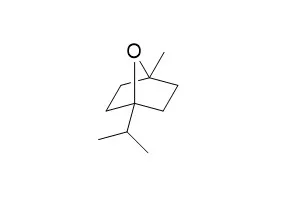| Animal Research: |
| Pharmacology Biochemistry and Behavior,2010,96(3):287-293. | | Anxiolytic-like effect of the monoterpene 1,4-cineole in mice.[Reference: WebLink] | Recent studies have shown that some monoterpenes exert anxiolytic- and depressant-like actions, however, these effects from monoterpene 1,4-Cineole are still unknown.
METHODS AND RESULTS:
This work aimed to study the effects of 1,4-Cineole in classic animal models for depression- and anxiety-like behavior, specifically the elevated plus maze (EPM), hole board, open field, pentobarbital sleeping time, forced swimming, tail suspension and rota rod tests. 1,4-Cineole was administered orally to mice (100, 200 and 400 mg/kg), while diazepam (1 or 2 mg/kg) and imipramine (10 or 30 mg/kg) were used as standard drugs. 1,4-Cineole (400 mg/kg) modified all parameters observed in the EPM, while no significant variation was observed on general motor activity in the open-field test. In the hole-board assay, 1,4-Cineole induced increase on the number of head dips. Forced swimming and tail suspension tests showed that cineole (200 and/or 400 mg/kg) was able to promote significant increase on the immobility time, while a decreased sleep latency was observed (200 and 400 mg/kg ) on the pentobarbital sleeping time. Cineole had no effect on the motor coordination of animals in the rota rod test.
CONCLUSIONS:
The results suggest that 1,4-Cineole presents potential anxiolytic-like action consistent with possible general depression of the CNS. |
|
| Structure Identification: |
| Journal of Essential Oil Research, 2001,13:37-42. | | Essential Leaf Oil of Persea Subgenus Eriodaphne and Closely Related Perseoid Genera.[Reference: WebLink] |
METHODS AND RESULTS:
The leaf oils of Persea caerulea, P. cinerascens, P. donnell-smithii, P. lingue, P. longpipes, P. pachypoda, P. palustris, P. skutchii, Beilschmiedia miersii, B. tarairie, Litsea calicaris, Nectandra umbrosa, N. salicina, Ocotea Valeriana and O. bothrantha were analyzed by GC and GC/MS.
CONCLUSIONS:
The major components of the Persea oils were sabinene (20.1%) and β-caryophyllene (11.0%) in P. caerulea; α-phellandrene (24.9%) and α-terpinene (18.9%) in P. cinerascena; α-pinene (20.5%), β-pinene (16.9%) and germacrene D (24.3%) in P. donnell-smithii; sabinene (14.5%), β-carophyllene (11.3%), germacrene D (11.6%) and Γ-cadinene (18.6%) in P. lingue; β-caryophyllene (6.5%) and α-humulene ((7.3%) in P. longpipes; β-terpinene (12.6%) and camphor (29.3%) in P. pachypoda; 1,8-cineole (33.7%) and camphor (10.2%) in P. palustris and α-pinene (14.8%), 1,8-cineole (12.3%), Γ-terpinene (12.8%) and germacrene D (12.2%) in P. skutchii. The oils of Beilschmiedia miersii and B. tarairie were found to be rich in α-terpinene (10.0%) and germacrene D (24.8%), and α-pinene (17.8%) and germacrene D (6.6%), respectively. Litsea calicaris oil contained δ-cadinene (38.2%) and T-muurolol (28.7%) as main constituents. The main constituents of the oils of Nectandra umbrosa and N. salicina were methoxsalen (24.5% and 30.1%) and indene (14.7% and 22.5%), respectively.
The oils of Ocotea Valeriana and O. botrantha were found to be rich in 1,4-Cineole (19.6%) and (Z)-anethole (13.4%), and δ-elemene (11.2%), β-caryophyllene (13.4%) and germacrene D (35.2%), respectively. |
|






 Cell. 2018 Jan 11;172(1-2):249-261.e12. doi: 10.1016/j.cell.2017.12.019.IF=36.216(2019)
Cell. 2018 Jan 11;172(1-2):249-261.e12. doi: 10.1016/j.cell.2017.12.019.IF=36.216(2019) Cell Metab. 2020 Mar 3;31(3):534-548.e5. doi: 10.1016/j.cmet.2020.01.002.IF=22.415(2019)
Cell Metab. 2020 Mar 3;31(3):534-548.e5. doi: 10.1016/j.cmet.2020.01.002.IF=22.415(2019) Mol Cell. 2017 Nov 16;68(4):673-685.e6. doi: 10.1016/j.molcel.2017.10.022.IF=14.548(2019)
Mol Cell. 2017 Nov 16;68(4):673-685.e6. doi: 10.1016/j.molcel.2017.10.022.IF=14.548(2019)